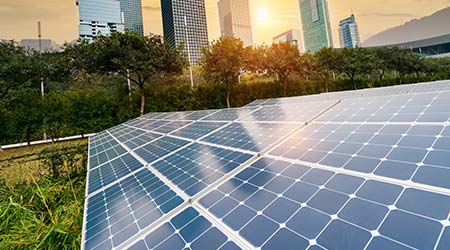Understanding Onsite Renewable Energy Options
Renewables combined with energy storage is becoming an increasingly and cost-efficient option for facility managers.
A distinct advantage of photovoltaics is that the energy source (the sun) is free, with no transport or storage costs. Side benefits of commercial photovoltaics can include covered parking and electric vehicle charging, much of which can allow energy to go straight from the sun into vehicles with almost zero power distribution losses.
Other forms of prime power generation include wind turbines, geothermal, and hydro-power. Most geographic locations don’t have these options, certainly not many urban areas.
In addition to onsite power generation, energy storage is increasingly becoming a viable option for facility managers. Traditional methods to reduce peak load demand and for peak shifting include chilled water storage, ice harvesting, etc. Now, lithium-ion and other battery technologies such as zinc-air, and even flywheels and ultra-capacitors, are increasingly in play, particularly when coupled to intermittent and soft, base-load sources such as photovoltaics and fuel cells. Onsite batteries are almost a necessity to operate photovoltaic systems in islanding mode.
At present, financing is a key component to making renewables like photovoltaics and fuel cells economically viable. Significant tax advantages and incentives from governments and utilities are available to reduce the ROI from more than 10 years closer to five years or less.
Microgrids — typically mixing technologies including photovoltaics and fuel cells (renewables), energy storage, CHP, and fossil fuel generation — are increasingly viable for campuses, airports, etc. Vehicle-to-grid power from a parking lot full of charged electric vehicle batteries could also soon be in the mix. Monitoring and control systems connect and disconnect from the utility grid to optimize costs.
Generating power onsite eliminates the need to transport power across great distances, which significantly reduces costs, energy losses, and environmental risks of forest fires caused by downed power lines. With continuing technology improvement, the cost of onsite power generation may soon rival the cost of utility power transmission and distribution, even if utility power generation (fossil fuel, hydro-power, and nuclear generating plants) could somehow approach zero cost.
Whatever onsite power generation technology a facility deploys, be sure to have it fully tested (commissioned) in all expected modes of operation, normal and emergency, and under all expected load conditions, and repeat performance testing during regular maintenance, if you expect it to operate as intended.
Related Topics:
















